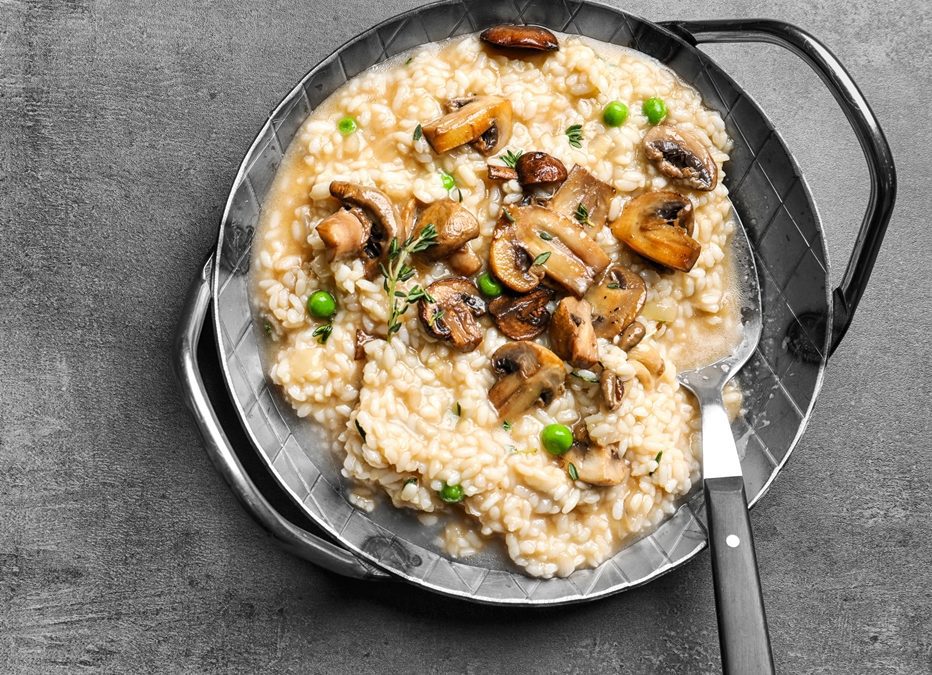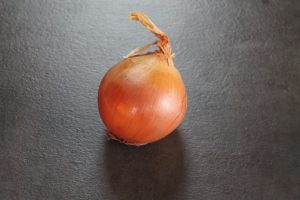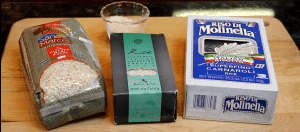Risotto is often described as a tricky, fussy – and a bit scary. Since nothing impresses as a well-executed risotto, The Serious Foodie has put together a risotto primer to debunk any of your risotto fears.
The aim of this article is to understand the different kinds of rice for risotto, the importance of good stock, and the basic techniques such as when to make additions. Risotto does take some attention, but the cooking method presented here is quite forgiving, and adaptable to many other grains.
Here we provide the basic risotto techniques using the classic risotto Milanese. You can find lots of recipes using vegetables (sauteed leeks and mushrooms, for example), seafood, and meat. You can build on these recipes and techniques by adding almost anything, or can be served simply with some chopped fresh herbs stirred in at the last moment.
We’ll then move onto showing how other types of grains can be made in the style of risotto – farro, quinoa, and whole wheat pasta. For example, check out our recipe for Risotto-Style Pasta.
For now, let’s start with the risotto basics….
What You’ll Need
There are four basic components to any risotto recipe: stock or broth (“brodo”, also including wine), aromatics (onion, garlic, etc. – called “soffritto”), rice (“riso”), and finishing components (such as butter, cream, cheese, etc. – called “condimenti”).
1. Broth
It is critical to use homemade, or a high quality store-bought stock or broth. There is nothing like homemade – so save up those chicken bones, shrimp shells, beef bones, etc., and make yourself a stock where you control the ingredients and taste. We really like the methods on TheKitchn.com, which uses the same techniques taught at the Culinary Institute of America (click HERE to see their stock & broth preparations). You’ll need a 4 to 5 quart sauce pan to keep the brodo warm, and a nice quality wine. Most risotto will use white wine (we always suggest Soave, but Pinot Grigio also works), but there are some interesting recipes that use red wine with red meat.
2. Soffritto
The most common component of soffritto is onion – either by itself, or combined with leeks, shallots, and/or garlic. Other components of soffritto can be carrots, celery, fennel, bell pepper, parsley. The soffritto usually gets sauteed before adding the rice.
3. Riso
Italian rice is not like domestic rice, or rice from the Far East – it is always high starch, and short or medium grain. It is critical to choose a rice variety having the ability to absorb liquids and to release starch – the Italian varieties are stickier than the typical long grain varieties.
The most common variety is Arborio, but you might also find Carnaroli or Vialone Nano at some specialty stores (also found on Amazon.com). Carnaroli and Vialone Nano are considered to be the best (and most expensive) varieties – they are our favorites, and worth sourcing & trying.
4. Condimenti
Condimenti provides the major source of variety – vegetables (spinach, peas, radicchio, asparagus, mushrooms, artichoke, etc.), meats (sausage, prosciutto, veal, chicken, lamb, etc.), fish and seafood (especially clams, mussels, and shrimp), cheese (mostly Parmesan, but also Fontina, mascarpone, Robiola, Gorgonzola, etc.). The condimenti gets added after the rice has mostly cooked. Many chefs will also add butter and/or cream to finish the dish.
The Basic Technique
Properly cooked risotto is rich and creamy but still with some resistance or bite (al dente), and with separate grains. The traditional texture is fairly fluid, or all’onda (“wavy, or flowing in waves”). It is served on flat dishes and it should easily spread out but not have excess watery liquid around the perimeter. It must be eaten at once as it continues to cook in its own heat and can become too dry with the grains too soft. Follow these techniques, and you’ll find yourself addicted to making risotto regularly.
- Brodo: Bring at least 5 1/2 cups of broth to a steady simmer in a sauce pan, and put on the lid until ready to use.
- Riso: Measure out 1 1/2 cups of rice
- Soffritto: Melt 3 tablespoons butter and 1 tablespoon olive oil in a heavy saute pan (at least 4 quarts) over medium heat. Add the soffritto ingredients, and saute for 2 minutes, just until the ingredients soften. Add the rice, and coat each grain in the fat, called tostatura. Pour in the wine (usually about 1/2 to 1 cup), and let the liquid mostly evaporate. When the wine has evaporated, the heat is raised to medium high and the hot stock is gradually added (1/2 cup at a time) while stirring gently, almost constantly. Stirring loosens the starch molecules from the outside of the rice grains into the surrounding liquid, creating a smooth creamy-textured liquid. The rice will be tender in 15 to 20 minutes after adding the first broth.
- Condimenti: Remove the pan from the heat, then add the condimenti ingredients (butter, Parmesan, etc.) while vigorously stirring to make the texture as creamy and smooth as possible.
Risotto Milanese
- Brodo – 5 cups basic broth (high quality chicken broth or stock)
- 1/4 teaspoon saffron
- 1/2 cup dry white wine (preferably Soave).
- Soffritto: 3 tablespoons unsalted butter
- 1 tablespoon olive oil
- 1/3 cup minced onion
- Riso: 1 1/2 cup risotto rice (Arborio, Vialone Nano, Carnaroli)
- Condimenti: 1 tablespoon unsalted butter
- 1/3 cup grated Parmesan
- Bring the broth to a steady simmer in a saucepan. Add the saffron, and stir. Leave the lid on until needed.
- Melt 3 tablespoons butter and 1 tablespoon olive oil in a heavy saute pan (at least 4 quarts) over medium heat. Add the onion, and saute for 2 minutes, just until softened.
- Add the rice, and coat each grain in the fat. Saute for 2 minutes.
- Pour in the wine, and let the liquid mostly evaporate.
- Raise the heat to medium high and begin to add the hot stock gradually, 1/2 cup at a time. Stir gently, almost constantly. Continue adding the broth and stirring. The rice will be tender in 15 to 20 minutes after adding the first broth; taste at one minute intervals.
- Remove the pan from the heat, then add the butter and Parmesan while vigorously stirring to make the texture as creamy and smooth as possible.




